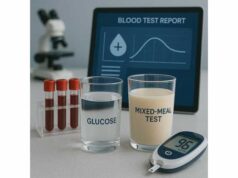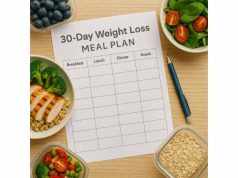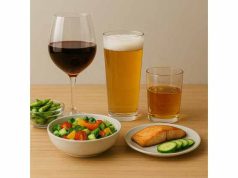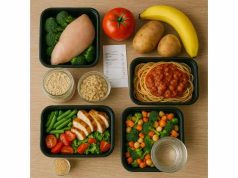
Most people do not overeat because they lack willpower. They overeat because their plan is vague. When you know your maintenance calories, pick a realistic deficit, and set protein first, the fog lifts. This guide shows you exactly how to choose daily calories for steady fat loss without wrecking energy or muscle. You will get simple formulas, worked examples, and meal-building templates you can repeat. If you want a broader foundation before you set numbers, skim our concise primer on calories, macros and meal planning, then come back and plug in your details.
Table of Contents
- How many calories to lose weight?
- Find your maintenance calories
- Set a safe calorie deficit
- Protein, carbs and fat targets
- Calorie examples and meal plans
- Mistakes and troubleshooting
- Results, timelines and expectations
- Frequently Asked Questions
How many calories to lose weight?
There is no single “correct” number for everyone. Daily calories depend on your size, body composition, activity, and appetite. A useful way to think about it:
- Maintenance calories: what you need to keep your current weight.
- Deficit calories: maintenance minus a sensible reduction (usually 300–600 kcal/day for most adults).
- Protein first: hit a daily protein target to protect muscle and curb hunger; let carbs and fat fill the rest.
Fast estimates to orient you
If you want a quick ballpark while you gather more data, multiply body weight (in pounds) by:
- 12–13 for a moderate deficit if you are lightly active.
- 11–12 if you have a sedentary job and few steps.
- 13–14 if you are quite active or have a lot of weight to lose and prefer a gentler start.
These are starting points, not verdicts. You will fine-tune based on progress over the next 3–4 weeks.
Why the “right number” is a range
Your energy needs change across the week. Steps vary, training varies, and even thermic effect of food shifts with protein intake. A range (e.g., 1,700–1,900 kcal) with a weekly average target is more realistic than a single daily number. Hitting your weekly average within ±100 kcal is excellent adherence.
Weight-loss pace to aim for
Most adults do well with 0.5–1.0% of body weight per week. Smaller or leaner people should prefer the lower end to protect energy and training. Larger people may see faster early drops that slow over time. Appetite, not math, often sets the ceiling: choose the largest deficit you can maintain while sleeping well and training.
Hunger and satiety levers
- Protein: 1.6–2.2 g/kg body weight keeps you fuller and preserves muscle.
- High-volume foods: vegetables, fruit, legumes, broth-based soups, and dairy or soy yogurt help you eat fewer calories with more food volume.
- Meal structure: 2–4 planned eating occasions beat “grazing” for most people.
Context matters
If you are choosing between approaches or want a broader view of sustainable strategies, our guide to healthy weight loss basics shows how calorie targets fit alongside movement, sleep, and food skills.
Find your maintenance calories
You can estimate maintenance with equations or pin it down from your real life. Use both: a formula for a starting number, then a two-week reality check from your own data.
Step A: Equation starting point
Use body weight multipliers for speed:
- Sedentary (≤5k steps/day): weight (lb) × 14–15
- Lightly active (6–8k steps): × 15–16
- Moderately active (8–12k steps or 3–4 training sessions): × 16–17
- Very active (≥12k steps or manual job): × 17–19
Example: 170 lb lightly active person → 170 × 15.5 ≈ 2,635 kcal maintenance.
Prefer metric? Multiply body weight (kg) × 30–36 depending on activity.
Step B: Log and verify
For two weeks:
- Eat as you usually do (or at your estimated maintenance).
- Track intake as accurately as you can.
- Weigh yourself daily, same time and conditions; take the weekly average.
- If average weight stays within ±0.25% across two weeks, you are near maintenance. If it drops, you were in a deficit; if it rises, you were in a surplus.
Step C: Cross-check with behavior-based cues
If detailed tracking is not your style, use structured estimating:
- Build plates with the Plate Method (½ produce, ¼ protein, ¼ starch, plus measured fats). It narrows portions without counting and teaches visual consistency. A quick visual guide is here: portion sizes by plate method.
What if your job or schedule changes?
Recalculate if you switch to a desk role, start commuting by bike, or add a new sport season. Maintenance is dynamic; treat it as a moving target you revisit quarterly or when routines shift.
Common pitfalls when estimating
- Under-counting oils, dressings, nuts, and cheese.
- Forgetting liquid calories: lattes, juices, alcohol, and smoothies.
- Logging “guesstimates” for restaurant meals that are lower than reality.
Tighten these for seven to ten days to calibrate, then relax to systems you can sustain.
Set a safe calorie deficit
Once you have maintenance, choose a deficit you can live with for at least 8–12 weeks. The goal is not to suffer; it is to progress while protecting training, mood, and muscle.
Pick your reduction
- Gentle: −250 to −300 kcal/day. Best for smaller or leaner individuals, or those prioritizing performance and recovery.
- Moderate (most common): −400 to −600 kcal/day. Balances pace and adherence.
- Aggressive (short bursts only): −700 to −800 kcal/day, if appetite and schedule allow and training is simple. Limit to 2–4 weeks, then return to moderate.
Worked examples (maintenance → deficit)
- 2,400 kcal maintenance → 1,900–2,000 kcal target (moderate).
- 2,800 kcal maintenance → 2,200–2,400 kcal target.
- 1,900 kcal maintenance → 1,400–1,600 kcal target.
Weekly averaging beats daily perfection
Aim for a weekly calorie budget (target × 7). If a social dinner runs high, balance with lighter days. Your body cares about the average more than a single meal.
When to adjust
- If weight and waist do not change for 3–4 weeks, reduce target calories by 5–10% (usually from added fats or snacks), or increase daily steps by 2,000–3,000.
- If energy or mood crater, raise calories by 150–250 and reassess sleep, stress, and protein before pushing harder.
Hunger management inside a deficit
- Front-load protein at each meal (25–45 g depending on size).
- Add high-volume, low-calorie foods: leafy salads, broth soups, berries, roasted vegetables.
- Use structured snacks (e.g., Greek yogurt, fruit, protein shake) instead of grazing.
- Keep zero- or low-calorie drinks handy. If you struggle with hunger, these simple appetite-reducing steps help most people within a week.
Red flags to avoid
- Chasing the smallest possible number.
- Slashing carbs or fats so hard that meals feel joyless or training suffers.
- Ignoring sleep; poor sleep sabotages calorie control.
Pick the smallest deficit that feels repeatable on ordinary days. That is the one that wins over months.
Protein, carbs and fat targets
Calories set the pace; macros shape how the deficit feels. Set protein first, then divide carbs and fats by preference, performance, and digestion.
Protein (non-negotiable floor)
- Target 1.6–2.2 g/kg body weight (about 0.7–1.0 g/lb).
- If you have a high body-fat percentage, base protein on goal weight or an estimate of lean mass.
- Split across meals for satiety and muscle retention.
Typical daily targets:
- 60 kg → 95–130 g
- 75 kg → 120–165 g
- 90 kg → 145–200 g
If you want a precise, body-weight–based number, see our guide to grams per day here: protein targets by body weight.
Carbs and fats (to taste and training)
Once protein is set, fill remaining calories with carbs and fats you enjoy and can digest well.
- Higher-carb, lower-fat works well for frequent lifters, team sports, and interval training.
- Moderate-carb, moderate-fat fits most people.
- Lower-carb, higher-fat can curb appetite for those who prefer savory foods.
Example (1,900 kcal target)
- Protein: 140 g → 560 kcal
- Remaining: 1,340 kcal
- Option A: 180 g carbs (720 kcal) + 69 g fat (620 kcal)
- Option B: 120 g carbs (480 kcal) + 95 g fat (860 kcal)
Fiber, volume, and micronutrients
- Aim for 25–35 g fiber/day from vegetables, fruit, legumes, and whole grains (as they fit your carbs).
- Include a variety of colors and protein sources (seafood, dairy or fortified alternatives, poultry, lean red meat, tofu, tempeh, legumes).
- Salt food to taste, especially if you sweat or live in a hot climate.
Macro flexibility
Perfection is not required. Hit your protein floor, keep the weekly calorie average in range, and let carbs and fats flex with schedule and appetite.
Calorie examples and meal plans
Use these templates to turn numbers into meals. Adjust portions to your target and preferences. Each day includes protein-anchored meals, generous produce, and measured fats.
1,400–1,500 kcal (smaller or leaner individuals)
- Breakfast: Greek yogurt (200 g) with berries and 1 tbsp chia; coffee or tea.
- Lunch: Tuna salad wrap on whole-grain tortilla, mixed greens, cucumber, pickles; apple.
- Dinner: Chicken breast, roasted broccoli, small baked potato, yogurt-dill sauce.
- Snack (optional): Cottage cheese (150 g) with cherry tomatoes.
1,700–1,800 kcal (most common start)
- Breakfast: Omelet (3 eggs) with spinach, mushrooms, goat cheese; slice of whole-grain toast.
- Lunch: Turkey burger (no bun), quinoa salad with peppers, olive oil–lemon dressing.
- Dinner: Salmon fillet, green beans, brown rice; side salad.
- Snack: Protein shake or fruit and nuts (portioned).
2,000–2,200 kcal (taller or more active)
- Breakfast: Oats cooked in milk, whey protein stirred in, banana, cinnamon.
- Lunch: Chicken thigh, couscous, arugula-tomato salad with vinaigrette.
- Dinner: Lean beef or tofu stir-fry with mixed vegetables over rice.
- Snack: Yogurt parfait with berries and crushed walnuts.
Vegetarian example (≈1,800 kcal)
- Breakfast: Tofu scramble with peppers and onions; whole-grain toast; orange.
- Lunch: Lentil and feta salad with cucumbers, olives, tomatoes, olive oil.
- Dinner: Tempeh curry with green beans and cauliflower rice; side salad.
- Snack: Protein shake with fortified plant milk.
Weekend and eating out
- Set a two-plate rule at restaurants: one plate for the main, one for shared sides or dessert.
- Ask for sauces on the side; measure with the fork-dip method.
- Keep your weekly average: if dinner is richer, make breakfast and lunch lighter and protein-heavy.
Want a full week you can copy and paste? See our high-protein 7-day plan for plug-and-play menus: 7-day meal plan.
Hydration and low-calorie volume
Broth soups, big salads, berries, and carbonated water stretch meals without stretching calories. Keep prepared vegetables in the fridge so “add volume” is a 60-second job.
Mistakes and troubleshooting
Fat loss stalls rarely come from “broken metabolism.” They come from small, repeated mismatches between plan and reality. Use this checklist to get moving again.
1) Under-counting calorie-dense foods
Oils, nuts, nut butter, cheese, creamy dressings, and desserts add up quickly. Weigh or measure them for seven days. Many people find 200–400 kcal/day they did not realize they were eating.
2) Low protein, high hunger
If you feel ravenous at night, your daytime protein is probably too low. Anchor meals with 25–45 g protein and add a high-protein snack in the afternoon. Hunger often normalizes within a week.
3) “Healthy” beverages
Smoothies, specialty coffees, juices, and alcohol can quietly erase your deficit. Keep them occasional, portioned, and tracked. If you drink, limit to 1–2 on one night per week and budget for it.
4) Sleep debt and stress
Short sleep amplifies cravings and reduces self-control. Protect 7–9 hours, dim screens earlier, and add a 10–20 minute walk after dinner. The effect rivals small macro tweaks.
5) Weekend drift
Two high-calorie nights can erase five disciplined days. Keep a minimum structure (e.g., two protein-anchored meals and a cap on drinks), and set a kitchen cutoff time.
6) Scale noise vs real plateaus
Daily weight swings reflect water, sodium, and hormones. Compare weekly averages. If weight, waist, and photos do not change for 3–4 weeks, reduce calories by 5–10% or increase steps by 2,000–3,000.
For a deeper dive into common pitfalls and fixes across diet styles, skim our quick guide: diet mistakes that stall progress.
Mindset matters
One off-plan meal changes nothing. Resume your usual plan at the next meal. Progress is the average of many ordinary days.
Results, timelines and expectations
What to expect in the first month
- Week 1: water shifts from lower sodium or fewer refined carbs may move the scale quickly. Focus on routine, not speed.
- Weeks 2–4: aim for 0.5–1.0% of body weight per week. Measurements and clothes often tell the truth faster than photos.
Training and daily movement
Resistance training 2–4 times per week protects muscle and keeps your resting energy burn higher during a deficit. Add walking: 8,000–12,000 steps/day is a reliable appetite and weight-management tool for most people.
When to take a break
If fatigue accumulates or performance drops, run a 1–2 week maintenance phase at your estimated maintenance calories with the same protein and meal structure. This helps recovery without losing momentum.
How long should fat loss take?
A 10% weight loss typically takes 10–20 weeks at a moderate pace. If you have more to lose, plan for phases: 8–12 weeks in a deficit, 1–2 weeks at maintenance, then repeat. This staged approach is easier to sustain.
What success looks like
- You can predict meals without a tracker because your plates are consistent.
- Protein is automatic.
- You sleep 7–9 hours most nights.
- You do not fear meals out because you know how to average your week.
Stay focused on repeatable behaviors. The number on the scale follows.
Frequently Asked Questions
What calorie deficit should I start with?
Most adults do well with a reduction of 300–600 calories below maintenance. Pick the smallest deficit that lets you progress while sleeping well and training. If energy crashes, raise calories by 150–250 and reassess protein, steps, and stress before pushing harder.
Will I lose weight faster if I eat 1,200 calories?
Only if 1,200 creates a deficit for you, but very low targets often backfire through hunger, low energy, and muscle loss. Choose a moderate deficit you can sustain for months. Smaller or leaner individuals should keep calories higher to protect performance and mood.
Do I need to count calories to lose weight?
Not always. Counting is a useful short-term calibration tool. Many succeed using structured plates, consistent meal timing, and protein-first planning. If progress stalls, track for seven to ten days to spot hidden calories, then return to simpler systems you can repeat.
How much protein should I eat while losing weight?
Aim for 1.6–2.2 grams per kilogram of body weight daily (about 0.7–1.0 grams per pound). Split protein across meals to reduce hunger and protect muscle. Larger people often benefit from setting protein based on goal weight or an estimate of lean mass.
Can I eat back exercise calories?
You can, but be conservative. Fitness trackers frequently overestimate burn. If you choose to “eat back,” start with half of the estimated exercise calories, watch weekly averages, and adjust based on your actual rate of loss and hunger signals.
How soon should I adjust my calories?
Give a new target 3–4 weeks. If weekly weight averages, waist measurements, and photos do not change, reduce calories by 5–10% or raise steps by 2,000–3,000 per day. If energy or mood suffer, consider a brief maintenance phase before resuming the deficit.
References
- Obesity Management in Adults A Review (2023)
- 8. Obesity and Weight Management for the Prevention and Treatment of Type 2 Diabetes: Standards of Care in Diabetes—2023 (2023) (Guideline)
- Systematic review and meta‐analysis of protein intake to support muscle mass and function in healthy adults (2022) (Systematic Review)
- Resistance training effectiveness on body composition and body weight outcomes in individuals with overweight and obesity across the lifespan: A systematic review and meta-analysis (2022) (Systematic Review)
- Lifestyle Modification Approaches for the Treatment of Obesity in Adults (2020)
Disclaimer
This article offers general education for adults and is not a substitute for personalized medical advice, diagnosis, or treatment. Always consult your healthcare provider before starting a calorie deficit—especially if you have diabetes, cardiovascular disease, kidney or liver conditions, are pregnant or breastfeeding, or have a history of disordered eating.
Share and follow
If you found this useful, please share it with someone setting their calorie target. For new guides and practical tools, follow us on the social platform you use most—Facebook, X, or another network you prefer.










